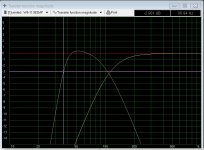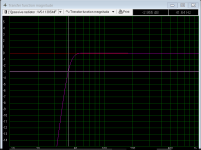Hi all,
After many years of thinking about how great it would be to build a set of speakers from scratch I've finally decided to give it a go.
I've selected a set of drivers, modelled them in WinISD and now I thought that I would post what I've done here for you guys to take a quick look over, see if I've made any glaringly obvious mistakes.
The idea is to build a reasonably small sound system, comprised of a pair of full way bookshelf speakers and a subwoofer; all powered by amps built into the boxes. (I'm not sure if I've posted in the right section here, so do feel free to move this thread if necessary)
It will be semi-portable in the sense that the bookshelf speakers will be able to clip onto the sides of the sub and the whole system picked up by hand, therefore being easy to move between rooms. It won't be battery powered though. So it will be designed to be reasonably lightweight and with smallish dimensions.
For the bookshelf speakers I've selected the Dayton Audio RS100-4, for the following reasons:
The only thing I'm wondering about is that the high end response gets a bit choppy above 1.5KHz; It's all within about 6dB.
Do you guys think this would be acceptable without a tweeter or equalisation?
Here's a link to the datasheet which shows the high end response:
Datasheet - RS100-4 > Loudspeaker Freaks
For the Subwoofer I've selected the Tang Band W5-1138SMF for it's:
The vent will fit OK within a cubic box if it has a 90 degree bend about half way through.
And either I'll get a plate amp with an adjustable crossover or build a set crossover.
What do you think? Does this seem like a reasonable design so far?
Any help is greatly appreciated! 🙂
Thanks,
Will
PS: I've attached a WinISD screenshot of the responses of the two drivers next to each other, with a second order butterworth crossover at 100Hz on the subwoofer.
After many years of thinking about how great it would be to build a set of speakers from scratch I've finally decided to give it a go.
I've selected a set of drivers, modelled them in WinISD and now I thought that I would post what I've done here for you guys to take a quick look over, see if I've made any glaringly obvious mistakes.
The idea is to build a reasonably small sound system, comprised of a pair of full way bookshelf speakers and a subwoofer; all powered by amps built into the boxes. (I'm not sure if I've posted in the right section here, so do feel free to move this thread if necessary)
It will be semi-portable in the sense that the bookshelf speakers will be able to clip onto the sides of the sub and the whole system picked up by hand, therefore being easy to move between rooms. It won't be battery powered though. So it will be designed to be reasonably lightweight and with smallish dimensions.
For the bookshelf speakers I've selected the Dayton Audio RS100-4, for the following reasons:
- 4 inch diameter
- Fairly low cost
- What seems to be a good full range response
The only thing I'm wondering about is that the high end response gets a bit choppy above 1.5KHz; It's all within about 6dB.
Do you guys think this would be acceptable without a tweeter or equalisation?
Here's a link to the datasheet which shows the high end response:
Datasheet - RS100-4 > Loudspeaker Freaks
For the Subwoofer I've selected the Tang Band W5-1138SMF for it's:
- 5 inch diameter
- Again reasonable price
- 40W RMS
The vent will fit OK within a cubic box if it has a 90 degree bend about half way through.
And either I'll get a plate amp with an adjustable crossover or build a set crossover.
What do you think? Does this seem like a reasonable design so far?
Any help is greatly appreciated! 🙂
Thanks,
Will
PS: I've attached a WinISD screenshot of the responses of the two drivers next to each other, with a second order butterworth crossover at 100Hz on the subwoofer.
Attachments
does look good so far.
maybe the reflex-port is a little bit small for a subwoofer with this possible excursion?
maybe the reflex-port is a little bit small for a subwoofer with this possible excursion?
Ok, I'll give a go at lowering the tuning frequency, see if I can get a bit more out of it with a bigger port.
What do you think about the high end of the full range drivers? Do you think they will sound OK without a tweeter?
What do you think about the high end of the full range drivers? Do you think they will sound OK without a tweeter?
i did not mean lowering the tuning freq 😀 i meant the port itself, the opening area should be 1/3 of the drivers effective area.
unfortunatly, i dont have any experience with the dayton fullrange'ers. but al i heard about them was positive 😀
unfortunatly, i dont have any experience with the dayton fullrange'ers. but al i heard about them was positive 😀
the length is a reason for passive radiators 😀
thats why 95% of these portabel speakers from companies work with passive radiators 😀
thats why 95% of these portabel speakers from companies work with passive radiators 😀
So after a lot of calculations and playing around I came up with the following Passive Radiator Design:
Active Driver: Tang Band W5-1138SMF
Passive Radiator (2 Used): Dayton Audio SD175-PR
Tuning Frequency: 42.99Hz
Internal Box Volume: 11.45L
Added Mass Per PR: 18.17g
Here Are the full calculations:
Passive Radiator Calculations (5 Inch Driver)
Active Driver maximum air displacement = 94 x 0.92 = 86.48cm^3
Require Passive Radiator with maximum air displacement >= 130cm^3
Passive Radiator Sd = 128.7 x 0.8 = 102.96cm^3
Therefore, two passive radiators would be required to meet the minimum air displacement.
Mass Calculations:
R (Equivalent Port Radius) = (2Sd/Pi)^0.5 = 9.05cm
L (Required Port Length) = (23562.5*Dv^2*Np/(Fb^2*Vb))-(k*Dv)
= (23562.5*18.1^2*1/(42.99^2*11.44))-(0.732*18.1)
= 351.61cm
Pv (Port Volume) = (Pi*R2)*L = 90519.86cm^3 = 0.9051986m^3
Ma (Total Added Mass) = Pv * Density of air = 0.9051986*1.23 = 0.111339kg = 111.34g
Md (Added Mass Per Driver) = (Ma- (2*37.5))/2 =18.17g
Looks good eh? Not quite as low response as the ported design but doesn't require a metre and a half of tubing...
I've attached the response plot too.
Active Driver: Tang Band W5-1138SMF
Passive Radiator (2 Used): Dayton Audio SD175-PR
Tuning Frequency: 42.99Hz
Internal Box Volume: 11.45L
Added Mass Per PR: 18.17g
Here Are the full calculations:
Passive Radiator Calculations (5 Inch Driver)
Active Driver maximum air displacement = 94 x 0.92 = 86.48cm^3
Require Passive Radiator with maximum air displacement >= 130cm^3
Passive Radiator Sd = 128.7 x 0.8 = 102.96cm^3
Therefore, two passive radiators would be required to meet the minimum air displacement.
Mass Calculations:
R (Equivalent Port Radius) = (2Sd/Pi)^0.5 = 9.05cm
L (Required Port Length) = (23562.5*Dv^2*Np/(Fb^2*Vb))-(k*Dv)
= (23562.5*18.1^2*1/(42.99^2*11.44))-(0.732*18.1)
= 351.61cm
Pv (Port Volume) = (Pi*R2)*L = 90519.86cm^3 = 0.9051986m^3
Ma (Total Added Mass) = Pv * Density of air = 0.9051986*1.23 = 0.111339kg = 111.34g
Md (Added Mass Per Driver) = (Ma- (2*37.5))/2 =18.17g
Looks good eh? Not quite as low response as the ported design but doesn't require a metre and a half of tubing...
I've attached the response plot too.
Attachments
- Status
- Not open for further replies.
- Home
- Loudspeakers
- Multi-Way
- Semi Portable Sound System Design

